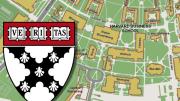Harvard Business School (HBS) today announced that Seth Klarman, M.B.A. ’82, and Beth Klarman have made the naming gift for Klarman Hall, a major new conference center/auditorium and performance space that will replace the existing Burden Hall, an auditorium built in 1971 and designed by the acclaimed architect Philip Johnson ’27, B.Arch. ’43. The new facility had been incorporated into the HBS elements of Harvard’s recent institutional master plan filings for Allston development. The project description, according to Harvard’s draft environmental impact report associated with the master plan filing (see pages 32-33), outlines 140,000 square feet of new construction, to be built in two phases:
- A 110,000-square-foot, three-story complex just south of Burden, to “house a modern, media-equipped auditorium seating approximately 1000, the size of one MBA class, and foyer, reception, meeting and service space to support world-class convening. It will connect to the Spangler Center, the center of MBA student life, and to academic buildings at the concourse (tunnel) level.” As part of the project, HBS envisioned extending the new Spangler Way.
- A 30,000-square-foot, two-story, below-grade facility for meeting and classroom space, on the current Burden site, once it is demolished. The central green will be extended.
(The environmental statement also characterizes the existing Burden auditorium as “too small for many of the School’s current gatherings” and notes that “the Hall’s lack of foyer and meeting space, support facilities, and accessibility, limit the School’s ability to host global events and create a first-class learning environment.” Considering its aesthetics and relationship to the larger campus, the statement continues, “Burden Hall was not built as part of the McKim, Mead and White campus, and is a windowless…building lacking a positive relationship with campus open spaces, pedestrian paths, and buildings. It is disconnected from other campus academic and student buildings, and does not contribute to a positive participant experience, or campus life. It constricts views and pedestrian connections between the HBS Central Green, the focus of the academic campus, and East Drive, an important pedestrian route.”)
The naming gift announced today was apparently secured during the quiet phase of HBS’s $1-billion capital campaign; in the April 25 launch events, Dean Nitin Nohria said that the funds required to proceed had been received.
The architect for the project will be William Rawn Associates (profiled in this Harvard Magazine cover story). The firm also designed HBS’s new executive-education residence, Tata Hall, dedicated last December—suggesting the rise of a new vocabulary for the campus as a whole.
In a statement in HBS’s news release, Seth Klarman said:
When you bring people with talent, vision, and ambition together in a space designed specifically to facilitate connections, conversation, and debate, the potential for transformative ideas and action is limitless. Beth and I believe game-changing innovations will emerge from this space. HBS has played an important and ongoing role in my life and it’s a privilege to able to give back to a school that has given us so much.
Beth Klarman, president of Klarman Family Foundation, said:
Harvard Business School was transformative for Seth. He is truly one of the school’s success stories—not just in his business success, but in the way he lives his life. Giving back has always been important to both of us and we hope the new convening center will be a place to develop and share ideas that have a meaningful and positive impact.
Seth Klarman is president and CEO of The Baupost Group, a value-oriented investment-management firm founded in 1982. By some accounts, it is among the largest and best-performing hedge funds in the entire industry, with several tens of billions of dollars under management. Read an HBS profile of Klarman here, and an account of his alumni achievement award here.
The Klarmans’ philanthropic activities have included a $32.5-million grant to the Broad Institute of Harvard and MIT, announced in 2012, consistent with their interest in medical research. According to HBS’s news release, both Klarmans are members of the school’s board of dean’s advisors, and Seth Klarman is an honorary chair of the HBS campaign. Seth Klarman’s Baupost colleague Scott Nathan ’89, J.D.-M.B.A. ’94, a managing director at the firm, was named an initial outside member of the Harvard Corporation’s revamped finance committee, under the governance reforms enacted in late 2010.
Commenting on the gift in the announcement, Dean Nohria said:
With this wonderful gift, the Klarmans enable us to bring together leaders—in academia, in business, and in policy—in a world-class way to spur not just dialogue but action. We know that if we can create a gathering place of high functionality and high purpose, and if we leverage our convening power within that space, we can significantly affect the public debate about issues that are of the greatest importance to people at this School, in this country, and around the globe. All this is in keeping with Harvard Business School’s mission of educating leaders who make a difference in the world.
President Drew Faust said:
Through their efforts in business, their engagement in their community, and their involvement in philanthropy and charitable work, Beth and Seth Klarman have set the highest possible standard for those who want to dedicate their resources, as they have stated, to “the service of society's greatest challenges.”
The new facility is expected to open in 2018; heavy construction is already under way at that end of the HBS campus, as the Chao Center (replacing Kresge Hall) is erected—occupancy is expected in 2016—and Baker Hall, an executive-education residence, undergoes a comprehensive renovation.
According to the news release, elements of the Klarman Hall complex include:
- state-of-the-art technology enabling connections with scholars and thought leaders around the world;
- stage and backstage capacity, acoustics, and equipment for spoken-word events, films, and cultural events;
- a multipurpose foyer; and
- pre-function reception space.
HBS’s campus building standard is for LEED Gold certification.
Architect William Rawn said of the assignment, “Given the wide range of events and gatherings that will take place in Klarman Hall, it’s imperative that the space be able to support, complement, and facilitate activities both big and small.” He noted that the new facility “will almost certainly combine an outstanding core auditorium with smaller breakout spaces of appropriate quantity and quality. Given the speed of change, the structure will certainly be designed to accommodate technologies that haven’t even been imagined yet.”
Read the HBS announcement here.








